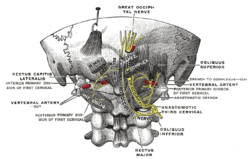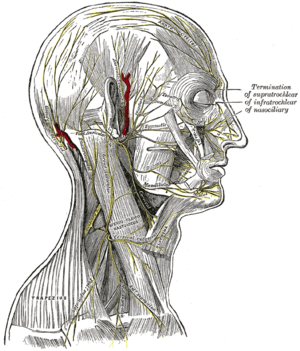Greater occipital nerve
| Greater occipital nerve | |
|---|---|
 Posterior primary divisions of the upper three cervical nerves. (Great occipital nerve labeled at center top.) | |
| Details | |
| From | C2 |
| Innervates | semispinalis capitis, scalp |
| Identifiers | |
| Latin | Nervus occipitalis major |
| TA | A14.2.02.008 |
| FMA | 65443 |
The greater occipital nerve is a spinal nerve, specifically the medial branch of the dorsal primary ramus of cervical spinal nerve 2. This nerve arises from between the first and second cervical vertebrae, along with the lesser occipital nerve. It ascends after emerging from below the suboccipital triangle beneath the obliquus capitis inferior muscle. It then passes through the trapezius muscle and ascends to innervate the skin along the posterior part of the scalp to the vertex. It innervates the scalp at the top of the head, over the ear and over the parotid glands.
Clinical relevance
Disorder of this nerve is one of the causes of cervicogenic headaches, referred to as occipital neuralgias. A common site, and usually misdiagnosed area of entrapment for the greater occipital nerve is at the obliquus capitis inferior muscle.[1]
Occipital pain management
Most people with tension headaches experience increasing intensity with time, and report pain originating in the back of the head (occipital) moving to the front of the head (supraorbital). Neurostimulation is sometimes used to treat tension headaches that originate from the occipital nerve.[2]
Notes
- ↑ Cho JC, Haun DW, Kettner NW, Scali F, Clark TB (July 2010). "Sonography of the normal greater occipital nerve and obliquus capitis inferior muscle". Journal of Clinical Ultrasound. 38 (6): 299–304. doi:10.1002/jcu.20693. PMID 20544865.
- ↑ Migraine Treatment Technology Explained http://www.reedmigraine.com/treat/conditions[]
Additional images
 Dermatome distribution of the trigeminal nerve
Dermatome distribution of the trigeminal nerve The nerves of the scalp, face, and side of neck.
The nerves of the scalp, face, and side of neck. Lateral head anatomy detail
Lateral head anatomy detail
External links
- Image at theberries.ns.ca
- http://www.dartmouth.edu/~humananatomy/figures/chapter_47/47-2.HTM
- http://www.dartmouth.edu/~humananatomy/figures/chapter_47/47-6.HTM